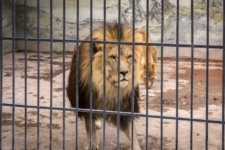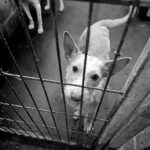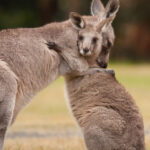The History of Laws Against Cruelty to Animals

Up until the middle of the Enlightenment (late 1600s to early 1800s), some of history’s most influential and revered philosophers and theologians enabled animal cruelty by professing that non-humans were non-sentient beings; in other words, lacking in the ability to experience sensations, thoughts or feelings, or to perceive through the use of sense faculties.
This led to a conclusion unfathomable to anyone with real-life exposure to a non-human animal – that what we now understand to be animal cruelty is a misnomer, as only humans are able to feel pain, and it is therefore moral to engage in conduct which would amount to cruelty if committed against a human.
Such a view was espoused by a laundry list of thought-leaders, including Aristotle, Saint Thomas Aquinas, Rene Descartes, Thomas Hobbes and Immanuel Kant.
For example, in his Meditations on First Philosophy (1641), Descartes theorised that non-human animals are autonomous beings that can do none of the things considered as thoughts and feelings in humans, leading many to cite him as a primary source of the view that ‘animal’s cannot feel pain’, and that it is therefore entirely moral to not only kill and eat, but to use and experiment on them in any manner desired.
The consequence of these views was that such act were considered totally permissible and even desirable until around the middle period of the Enlightenment.
Historical mistreatment
Indeed, thousands of years before the arrival of Christ, animals were mistreated in numerous ways which had nothing to do with killing to feed society.
From times of ancient wars, pulling chariots into battle, to Hannibal attaching flaming material to the horns of cattle and elephants, the screams of the tortured animals should have been proof enough of the ludicrous albeit reasoned opinions of the theorists.
The masses were entertained by both animal and human torture in the Roman Colosseum and like arenas throughout ancient times, and the public in Medieval Britain reveled in the spectacle of bear and dog baiting, resulting in horrific deaths purely for entertainment purposes.
Modern versions of such entertainment include cock fighting, dog blood sport and both greyhound and horse racing which is not properly regulated to protect against cruelty.
To this day, there is trophy hunting of large and often-endangered game animals, with primarily men showing their manhood by shooting defenceless animals, and decapitating and displaying their heads or bodies.
But things have changed through history, albeit slowly and in a piecemeal fashion, and laws to protect animals against abuses were brought into effect.
Impetus for change
Although various laws and informal prohibitions had been implemented prior to this time, 1822 saw the first British Law introducing criminal laws against animal cruelty, albeit limited to cattle.
The Royal Society for the Prevention of Cruelty to Animals (RSPCA) was established by a group of animal activists two years later in 1824, over coffee in a London Café.
The organisation was initially called the Society for the Prevention of Cruelty to Animals until, in 1840, Queen Victoria gave Royal Assent to add ‘Royal’ to its name.
The body successfully lobbied for Britain’s first general laws against animal cruelty, which were enacted in 1835.
A catalyst for the proliferation and enhancement of such laws were the widely-read and respected works of William Youatt. In 1839, the English Veterinarian Surgeon began to author books on his experiences with animals, which opened the eyes of many to the fact non-human animals experience a range of emotions and feelings, including pain.
Charles Darwin’s iconic work, On the Origin of Species, published in 1859, supported this view through the gound breaking finding that humans and animals have a shared evolution. The inference, of course, is both must therefore share feelings, including that of pain.
But it should be said that, to this very day and even in places like our very own state of New South Wales, laws against animal cruelty are subject to a very broad range of exceptions and defences, and are often rarely enforced.
In any event, the following table provides a chronology of various influential events and milestones impacting on the protection of animals.
Chronology of events impacting on animal protection
| Year | Occurrence |
| 530 BCE | Vegetarian Greek philosopher Pythagoras first espoused the idea that animals have souls and should therefore be respected and treated compassionately, and not tortured, killed or eaten. |
| 269– 232 BCE | Buddhist Indian emperor Ashoka advocated vegetarianism and took active steps to protect both domestic and wild animals. |
| 100s | Greek doctor and philosopher Galen conducted experiments on live animals (vivisection), paving the way for this form of research to become the norm far and wide. |
| 675 | Japanese Buddhist Emperor Tenmu imposed a prohibition on any form of meat, except for fish and animals in the wild. |
| 973–1057 | Syrian philosopher and author Al-Ma’arri became the first known vegan, at least by choice. |
| 1635 | The Irish Parliament passed legislation banning prevalent practices such as pulling the wool off live sheep (rather than clipping), which is believed to be one of the first known laws against animal cruelty. |
| 1641 | French philosopher René Descartes argued that animals were autonomous, non-sentient beings, analogous to machines, arguing it was moral, proper and even desirable to perform experiments on them for the good of mankind. |
| 1641 | Massachusetts in the United States passed rules prohibiting cruelty to domestically kept animals. |
| 1687 | Japanese reintroduced its ban on killing animals and eating meat. |
| 1780 | British philosopher Jeremy Bentham sparked interest in the idea that animals may feel pleasure and pain, famously positing, “The question is not, Can they reason? nor, Can they talk? but, Can they suffer?” |
| 1822 | Britain passed legislation to protect against extreme cruelty to cattle. |
| 1824 | The world’s first animal protection organisation was established. Originally named the Society for the Prevention of Cruelty to Animals, it later obtained royal assent and renamed the Royal Society for the Prevention of Cruelty to Animals (RSPCA). |
| 1824 | Author, vegan and anti-vivisectionist Lewis Gompertz published Moral Inquiries on the Situation of Man and of Brutes, advocating for animal rights. |
| 1835 | Britain passed its first piece of legislation expanding the prohibition against animal cruelty beyond cattle and to include such acts as bear-baiting and cock-fighting. |
| 1839 | English Veterinarian Surgeon, William Youatt, authored works on his experiences with animals, calling for greater protections. |
| 1847 | The term vegetarian was coined and the Vegetarian Society founded in Britain. |
| 1859 | Charles Darwin’s On the Origin of Species was published, demonstrating that humans are the evolutionary descendants of non-human animals. |
| 1863 | Anglo-Irish author and philosopher Frances Power Cobbe publishes The Rights of Man and the Claims of Brutes, arguing against animal experimentation. |
| 1866 | The American Society for the Prevention of Cruelty to Animals was established. |
| 1866 | Meat eating once again becomes the norm in Japan. |
| 1875 | Frances Power Cobbe founded the National Anti-Vivisection Society in Britain. |
| 1876 | Britain passed laws to regulate animal experimentation. |
| 1877 | British novelist Anna Sewell’s Black Beauty triggered interest in the protection of horses, and to a lesser extent all animals. |
| 1892 | Social reformer Henry Stephens Salt published Animals’ Rights: Considered in Relation to Social Progress, an early exposition of the philosophy of animal rights. |
| 1902 | The International Convention on the Protection of Birds Useful to Agriculture was signed in Paris, France. |
| 1903 | The vivisection of an only partially anaesthetized dog before a classroom of students at the University College of London sparked fierce debate about animal experimentation. Known as the Brown Dog affair, debate lasted until 1910. |
| 1906 | American J. Howard Moore built upon Darwinian theories of shared evolution to argue for humane treatment of all animals. |
| 1933 | Nazi Germany introduced the law Reichstierschutzgesetz, or the Reich Animal Protection Act, which introduced sweeping laws for the protection of animals – by far the most comprehensive protections to that date. |
| 1944 | Britain Donald Watson coined the word “vegan” and founded The Vegan Society. |
| 1950 | The International Convention on the Protection of Birds was signed in Paris, France. |
| 1955 | The first American organisation for animal welfare is established in the United States. The Society for Animal Protective Legislation (SAPL) lobbies for the humane slaughter of animals. |
| 1958 | Lobbying by the SAPL leads to the American Humane Slaughter Act being passed. |
| 1960 | India passed the Prevention of Cruelty to Animals Act, its first law against animal cruelty. |
| 1964 | The Hunt Saboteurs Association was founded in England to sabotage hunts and the use of animals in bloodsports. |
| 1964 | British writer Ruth Harrison’s Animal Machines details the conditions faced by animals on industrial farms and adds impetus to the movement for the protection of animals. This leads to a parliamentary investigation that year, establishing the principle that animals must “have sufficient freedom of movement to be able without difficulty to turn around, groom itself, get up, lie down, [and] stretch its limbs.” |
| 1966 | The American Animal Welfare Act was passed, setting standards for the transportation and sale of animals, and introducing rules for animal experiments. |
| 1968 | The European Convention for the Protection of Animals during International Transport establishes standards for livestock transportation in Europe. |
| 1970 | American animal rights activist Richard Ryder coined the term “speciesism” to describe the devaluing of non-human animals. |
| 1971 | The US Department of Agriculture excluded birds, mice, and rats from protection under the Animal Welfare Act. |
| 1971 | Oxford philosophers Stanley and Roslind Godlovitch, and John Harris publish Animals, Men and Morals arguing for animal rights. |
| 1973 | The International Trade in Endangered Species of Wild Fauna and Flora (CITES) was adopted in Washington, D.C. |
| 1974 | American Henry Spira founded Animal Rights International. |
| 1974 | The Council of Europe passed a directive to require that animals be made unconscious before they are slaughtered. |
| 1975 | American Peter Singer published the highly-influential book Animal Liberation, detailing conditions of animals on farms and in laboratories and arguing for animal rights. |
| 1976 | The militant Animal Liberation Front was established in Britain. |
| 1976 | The European Convention for the Protection of Animals kept for Farming Purposes was established, requiring that the “physiological and ethological needs” of animals were met. |
| 1977 | Animal Rights International successfully campaigned to end harmful experiments performed on cats at the American Museum of Natural History. |
| 1979 | New South Wales in Australia enacts the Prevention of Cruelty to Animals Act which imposes rules against cruelty to animals, subject to an extremely broad range of exceptions. |
| 1979 | Bolivia, Chile, Ecuador and Peru signed the Convention for the Conservation and Management of the Vicuña. Argentina signed in 1981. |
| 1979 | The European Convention for the Protection of Animals for Slaughter was signed, which directed members to adopt consistent, humane methods of slaughter. |
| 1980 | A campaign in the United States against animal experimentation by cosmetic company Revlon resulted in the company making a $250,000 grant to Rockefeller University. This resulted in an industry wide move away from such experiments. |
| 1980 | People for the Ethical Treatment of Animals (PETA) was founded in the United States. |
| 1981–1983 | An undercover investigation into experimentation on Monkeys in the United States led to the arrest and criminal prosecution of the alleged perpetrator. He was convicted but this was later overturned on the basis that state animal welfare laws did not apply to federally-funded experiments. |
| 1982 | The International Whaling Commission (IWC) banned commercial whaling, effective by 1986. |
| 1983 | United States philosopher Tom Regan published The Case for Animal Rights, a highly influential philosophical argument that animals had rights. This was distinguished from Singer’s argument that it is in the best interests of society not to inflict cruelty on animals (a utilitarian argument). |
| 1986 | The European Convention for the Protection of Vertebrate Animals used for Experimental and other Scientific Purposes to regulate the treatment and protection of test animals was adopted. |
| 1987 | The European Convention for the Protection of Pet Animals promote the welfare of pets and ensure minimum standards for their treatment and protection was adopted. |
| 1989 | The first known course for animal rights was taught Rutgers Law School in the United States. |
| 1992 | Switzerland became the first country to include protections for animals in its constitution. |
| 1997 | The European Union’s Protocol on Animal Protection was annexed to the treaty establishing the European Community, formally recognizing animals as sentient beings requiring care, ethical safeguards and protection. |
| 1998 | The European Union passed a directive Concerning the Protection of Animals Kept for Farming Purposes, requiring freedom from hunger, thirst, discomfort, pain, injury, disease, fear and distress as well as to express normal behaviour. |
| 1999 | Frenchman Willem van Eelen secured the first patent for in vitro meat. |
| 1999 | The European Union directed minimum standards for keeping egg laying hens, banning battery cages. |
| 2000–2009 | Bans on fur farming were instituted in the United Kingdom, Austria, Netherlands, Switzerland, Croatia, and Bosnia and Herzegovina. |
| 2003 | The revised European Convention for the Protection of Animals during International Transport increased the ethical standards for livestock transportation. |
| 2006 | Europe banned the use of veal crates.. |
| 2008 | California in the United States imposed rules requiring that a chicken “be able to extend its limbs fully and turn around freely”. This fell short of a ban on battery cages. |
| 2008 | Spain made recommendations that non-human primates have the right to life, liberty, and freedom from use in experiments. This was never made legally binding. |
| 2009 | Bolivia became the first country to ban all animal use in circuses. |
| 2010 | A European directive “on the protection of animals used for scientific purposes” instituted stringent ethical and welfare standards for the treatment of animals. |
| 2011–2016 | Parts of the United States introduced “ag-gag” laws which criminalised trespass onto property with a view to thwarting cruelty to animals. |
| 2012 | A group of prominent scientists issued the Cambridge Declaration on Consciousness proclaimed that all animals are sentient beings. |
| 2012 | Europe’s ban on battery cages became effective, but farmers circumvented the ban by providing furnished cages. |
| 2013 | The world’s first cultured meat product, a hamburger patty, was tested in London. |
| 2013 | The Nonhuman Rights Project filed the first-ever lawsuits on behalf of chimpanzees, demanding courts grant them the right to bodily liberty via a writ of habeas corpus. The petitions were denied |
| 2013 | The United Kingdom’s The Animals (Scientific Procedures) Act 1986, was amended to protect “…all living vertebrates”. |
| 2013 | Europe banned cosmetic testing on animals. |
| 2014 | The American Animal Cruelty Investigations School was established to provide to provide training on animal cruelty investigations. |
| 2014 | India became the first country in Asia to ban testing cosmetics on animals as well as imports of animal-tested cosmetics. |
| 2015 | New Zealand passed the Animal Welfare Amendment Bill, declaring animals to be sentient beings. |
| 2018 | The United States Dog and Cat Meat Trade Prohibition Act made it illegal to slaughter a dog or cat for food, unless for ritual slaughter. |
| 2019 | California in the United States banned the sale and manufacture of animal fur, except for cowhide or those necessary for religious purposes. |
| 2019 | Germany ruled that the existing way of killing unwanted chicks “violates the country’s laws against killing animals without a justifiable reason.” |
| 2020 | Britain ruled that ethical veganism is a “philosophical belief” and therefore is protected in law. |
| 2020 | The first cultured meat product in the world entered the market in Singapore. |
| 2020 | The European Court of Justice ruled that member states may require a reversible pre-cut stunning procedure during ritual slaughter. |
| 2021 | United States recognized animals as “interested persons” for the first time. |
| 2021 | The United Kingdom passed legislation formally recognizing animals as sentient beings. |
| 2021 | Spain approved a law recognizing animals as sentient beings. |
| 2022 | Switzerland conducted an ultimately unsuccessful ballot to enshrine the basic rights of all non-human primates in the cantonal constitution. It was the first national ballot of its kind in the world. |
| 2022 | Germany and France jointly became the first countries to prohibit all chick culling. |
History’s most evil person enacts sweeping laws to protect animals
There can be no words to sufficiently encapsulate the appalling atrocities perpetrated by one of history’s most evil people, Adolf Hitler, and his fascist Nazi party.
And one must take special care before giving credit for any act to the person at the helm of history’s most disgusting and shameful political, social and cultural regime, whereby millions of innocent men, women and children were tortured and murdered, including the systematic use of humans for medical experimentation, annihilation of ‘undesirable’ groups in society including the disabled and slaughter of large segments of targeted racial and religious groups.
Hitler and his extreme right-wing party exemplified the very worst of humankind, and the regime’s ultimate demise was a Godsend to all moral people.
But the irony must also be acknowledged that while on the way to murdering millions of human beings, the famously vegetarian and dog-loving Hitler took unprecedented steps to protect non-human animals from cruelty. And many of the enacted laws go way further than present day legislation.
In that regard, 24 November 1933 saw the German parliament (the Reichstag) the under the Chancellorship of Hitler and Presidency of Hermann Göring) pass the Reichstierschutzgesetz, or Reich Animal Protection Act, which is listed in the above table.
The law imposed a total ban on the almost-universally accepted, and even encouraged and publicly funded, practices of vivisection (operating or experimenting on live animals) and slaughter of animals without anaesthetic.
In a 1933 speech approved by Hitler, Göring declared an end to the “unbearable torture and suffering in animal experiments” and warned that those who “still think they can continue to treat animals as inanimate property” would be sent to concentration camps.
The regime saw a range of further prohibitions to protect animals including bans on animal trapping, the boiling of crustaceans such as crabs and lobsters, live baiting, neglect and cruel acts to domestic animals, and severe restrictions on hunting.
And so it was – perhaps history’s most evil regime was ironically perhaps the most benevolent in the treatment of non-human animals.
Present day laws against animal cruelty in Australia
Each Australian jurisdiction has specific legislation in place which is aimed at bringing those who inflict cruelty to animals to account, and deter others from engaging in such conduct.
New South Wales, for example, has the Prevention of Cruelty to Animals Act 1979 which has been amended several times since its enactment.
And while police in all states and territories have the power to prosecute animal cruelty, this can also be undertaken by organisations such as the Royal Society for the Prevention of Cruelty to Animals (RSPCA), which has offices in every jurisdiction.
Laws against animal cruelty in New South Wales
Section 5 of the Prevention of Cruelty to Animals Act 1979 (NSW) (‘the Act’) makes it an offence to commit ‘an act of cruelty’ upon an animal.
Section 4 of the Act defines an ‘animal’ as:
A member of a vertebrate species including any:
- amphibian,
- bird,
- fish,
- mammal (other than a human being), or
- reptile.
The definition also includes crustaceans, but only when at a building or place – such as a restaurant – where food is prepared or offered for consumption by retail sale in the building or place.
What is ‘cruelty’?
The same section defines ‘cruelty’ as including any beating, kicking, wounding of an animal, exposure to excessive heat or cold or inflicting pain on an animal.
Cruelty also includes failing to take reasonable care of an animal, or to take reasonable steps to alleviate pain or suffering, or to provide necessary veterinary treatment.
It is also an offence to authorise another person to commit an act of cruelty on an animal that you own, or are in charge of.
The maximum penalty for animal cruelty is 6 months imprisonment and/or a fine of $5,500 for an individual, or a $27,500 fine for a corporation.
The offence of aggravated animal cruelty in NSW
Section 6 of the Act relates to ‘aggravated cruelty’, which is defined by section 4 as:
(a) causing the death, deformity or serious disablement of the animal, or
(b) where the animal is so severely injured, so diseased or in such a physical condition that it is cruel to keep it alive.
The offence is made out where such an act is deliberately or recklessly caused.
A person is ‘reckless’ if he or she foresaw the possibility of any of the above occurred, but went ahead with the actions regardless.
The maximum penalty for aggravated animal cruelty is 2 years imprisonment and/or a fine of up to $22,000 for individuals, or a fine of $110,000 for corporations.
There are many defences to animal cruelty charges
A whole range of defences to animal cruelty are contained in section 24 of the Act, including religious slaughter; see section 24(c)(i) below.
The section says that a person is not guilty of animal cruelty where the act was committed against:
- a stock animal–in the course of, and for the purpose of, ear-marking or ear-tagging the animal or branding, other than firing or hot iron branding of the face of, the animal,
- a pig of less than 2 months of age or a stock animal of less than 6 months of age which belongs to a class of animals comprising cattle, sheep or goats–in the course of, and for the purpose of, castrating the animal,
- a goat of less than 1 month of age or a stock animal of less than 12 months of age which belongs to the class of animal comprising cattle–in the course of, and for the purpose of, dehorning the animal,
- a sheep of less than 6 months of age–in the course of, and for the purpose of, tailing the animal, or
- a sheep of less than 12 months of age–in the course of, and for the purpose of, performing the Mules operation upon the animal, in a manner that inflicted no unnecessary pain upon the animal,
It is also a defence where the act of cruelty is done in the course of, and for the purpose of:
- hunting, shooting, snaring, trapping, catching or capturing the animal, or
- destroying the animal, or preparing the animal for destruction, for the purpose of producing food for human consumption, in a manner that inflicted no unnecessary pain upon the animal.
A further defence is where the cruelty was inflicted in the course of, and for the purpose of, destroying the animal, or preparing the animal for destruction:
- in accordance with the precepts of the Jewish religion or of any other religion prescribed for the purposes of this subparagraph, or
- in compliance with any duty imposed upon that person by or under this or any other Act.
An additional defence is where the cruelty occurred in the course of, and for the purpose of:
- carrying out animal research, or
- supplying animals for use in connection with animal research,
in accordance with the provisions of the Animal Research Act 1985.
Another defence is where the act was undertaken for the purpose of feeding a predatory animal lawfully kept by the person if:
- the act concerned was the release of live prey for the predatory animal, and
- the diet of the predatory animal included animals of the kind released, and
- the person believed on reasonable grounds that the feeding of live prey to the predatory animal was necessary for the predatory animal’s survival because the predatory animal would not eat a dead animal or meat from a dead animal.
General legal defences to the charge also apply, including the defences of duress and necessity.
The defences are clearly broad to the point of being almost sweeping, and cover a significant number of the circumstances in which cruelty is inflicted on animals.
That being so, it is fair to say our state has a long way to go to provide real protections to animals.
The offence of serious animal cruelty in NSW
Section 530 of the Crimes Act 1900 (NSW) makes it an offence punishable by a maximum penalty of 5 years in prison to commit an act of ‘serious animal cruelty’, which is where a person, with the intention of inflicting severe pain:
(a) tortures, beats or commits any other serious act of cruelty on animal, and
(b) kills or seriously injures or causes prolonged suffering to the animal.
For the purposes of the offence,
- an “animal” is defined as a mammal (other than a human being), a bird or a reptile, and
- to “kill or seriously injure” an animal includes using the animal as a lure or kill, and
- a “serious act of cruelty” includes using the animal as a lure or kill.
The section imposes a 3 year maximum penalty where the act was committed recklessly rather than intentionally.
A person is not criminally responsible for the offence if the conduct occurred:
- in accordance with an authority conferred by or under the Animal Research Act 1985 or any other Act or law, or
- in the course of or for the purposes of routine agricultural or animal husbandry activities, recognised religious practices, the extermination of pest animals or veterinary practice.
Again, duress and necessity are defences to this charge.
The case study of the elephant
Elephants suffering from Post Traumatic Stress Disorder is a significant issue.
From the early 1960s through to the 1990s, those running wildlife reserves were concerned that growing numbers had the potential to destroy the land.
Culling, by murdering the elephants by shooting them from helicopters was introduced.
National Geographic reported that Animal Clinicians assessed that any surviving elephant would be too distressed by their companion’s demise that they couldn’t function on a normal basis.
South Africa’s Kruger National Park was where 14,562 elephants were executed, the park’s elephant specialist, Ian Whyte told the National Geographic magazine.
Psychology tests were conducted by scientists on surviving elephants of the massacre over a 28 year period and found that the experience had damaged their social skills.
Other Findings suggested that, like humans, elephants rely on social nuances to reproduce offspring, however, it gets worse.
25,000 majestic creatures slaughtered annually
This time, purely and simply, for the ivory their tusks provide for a multi-billion dollar Organised Transnational Criminal Enterprise.
Amongst the many countries facilitating this vast global money-making conglomerate are Egypt and China. Each slaughtered elephant has tusks worth us$2,500, only to reap many multiples of that figure at point of sale.
Death Squads hunt their prey with automatic weapons, not always killing them, but leaving them with horrific bullet wounds on many parts of their bodies.
The saviours
Nature Conservancy, a global environmental organisation headquartered in the United States of America, but with 79 branches throughout the globe, including Australia, may be considered one of the saviours in relation to prevention of cruelty to animals.
They assist in funding armed Rangers to endeavour to protect the elephants.
That’s not all they do. It’s much bigger than that!
They research, prepare policy papers and provide training and funding for many conservation projects.
Protecting the vulnerable
This is done by tranquilizing the elephants and sawing off their tusks, so that they will not be hunted.
The United Nations Science-Policy Platform and Biodiversity and Ecosystem Services 2019 report, speaks of another form of animal cruelty.
This, the result of a 3 years study involving 50 countries and endorsed by 130 countries, discusses the potential extinction, within decades, of many thousands of all types of animal life.
Causes include habitat destruction, pollution, climate change and the over-hunting of livestock, including the harvesting of marine life. All perpetrated by human beings.
It was the first time consultation was sought from multiple Indigenous populations, which enhanced the overall input; leading to being able to implement strategies without waiting for the preparation of the full report.
Subsequent reports indicate that over the previous two centuries, a third of mammals have become extinct as a result of human conduct.
Conservation of ecosystems generally
The protection of animals and particularly preventing endangerment and extinction goes hand-in-hand with protecting natural environments generally, which is sometimes referred to as nature conservancy.
According to multiple peer reviewed studies, the objective of nature conservancy is to:
- Produce more food on less land as deforestation impacts negatively on climate change, which causes an overuse of the globe’s fresh water; with the potential of damaging natural habitats.
It could also release more carbon into the atmosphere and perhaps dry the rivers up.
- Reduce too much fishing, as this could perhaps lead to close to extinction of some species not only disturbing sea ecosystems; but ultimately putting at risk many people who rely on seafood industries.
The statistic quoted is 84% of fish could be at risk of extinction, if we are not successful. Not immediately though, but time is not particularly on our side.
- Improve production of clean energy, by minimising carbon emissions to at least, levels agreed in the Paris Climate Agreement (An agreement legally binding on 196 countries adopted in Paris in 2015, that each nation reduces their carbon emissions).
The following recommendations have been made with a view to achieving these objectives:
- Poduce more food using less water and less land, which may be possible through utilising satellite imaging to pinpoint land which can be used for agricultural purposes without damaging natural habitats,
- Fish only what is needed, without overfishing, by using image recognition technology to identify where can be fished without exhaustive the resource or damaging the environment, and
- Making greater use of non-fossil fuel sources and improved reforestation that captures carbon dioxide.
Implementing these suggestions can go some way towards protecting natural ecosystems while maintaining and indeed protecting animals.







